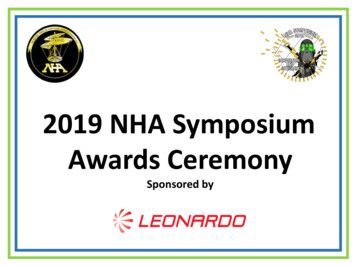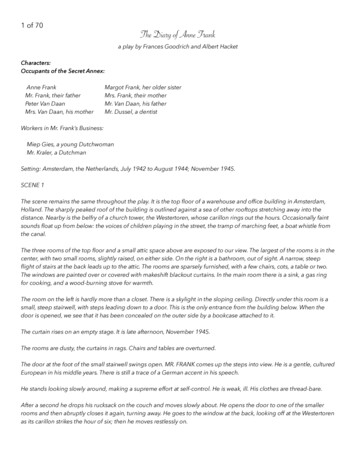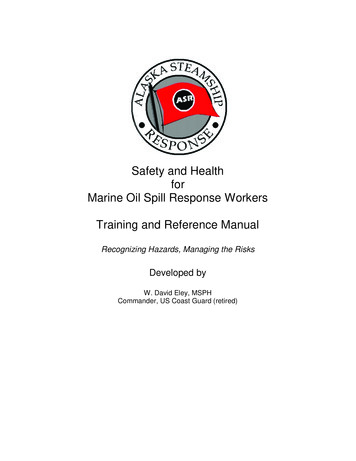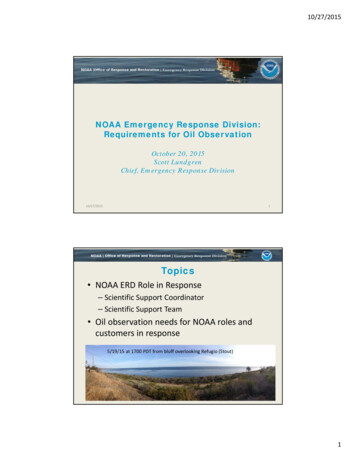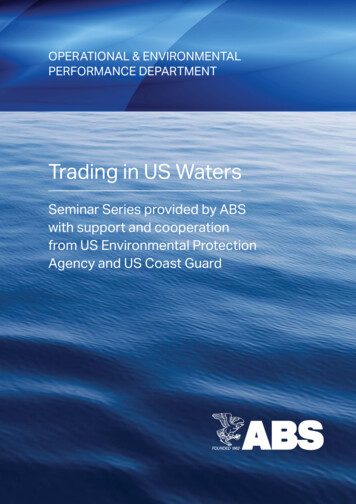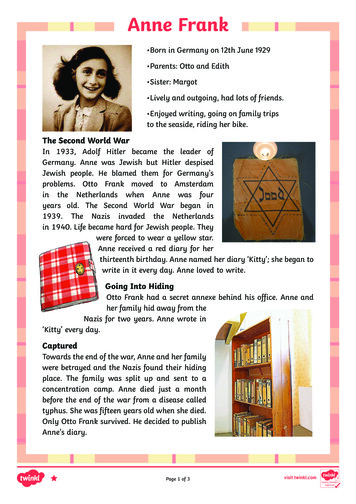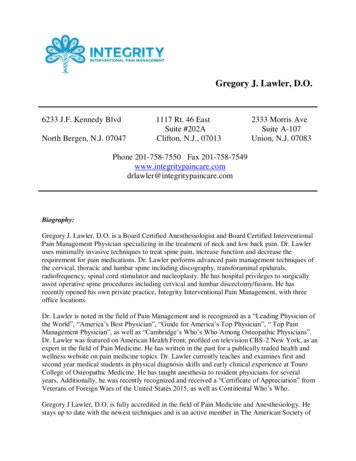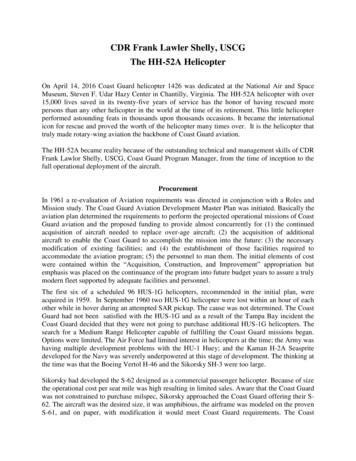
Transcription
CDR Frank Lawler Shelly, USCGThe HH-52A HelicopterOn April 14, 2016 Coast Guard helicopter 1426 was dedicated at the National Air and SpaceMuseum, Steven F. Udar Hazy Center in Chantilly, Virginia. The HH-52A helicopter with over15,000 lives saved in its twenty-five years of service has the honor of having rescued morepersons than any other helicopter in the world at the time of its retirement. This little helicopterperformed astounding feats in thousands upon thousands occasions. It became the internationalicon for rescue and proved the worth of the helicopter many times over. It is the helicopter thattruly made rotary-wing aviation the backbone of Coast Guard aviation.The HH-52A became reality because of the outstanding technical and management skills of CDRFrank Lawlor Shelly, USCG, Coast Guard Program Manager, from the time of inception to thefull operational deployment of the aircraft.ProcurementIn 1961 a re-evaluation of Aviation requirements was directed in conjunction with a Roles andMission study. The Coast Guard Aviation Development Master Plan was initiated. Basically theaviation plan determined the requirements to perform the projected operational missions of CoastGuard aviation and the proposed funding to provide almost concurrently for (1) the continuedacquisition of aircraft needed to replace over-age aircraft; (2) the acquisition of additionalaircraft to enable the Coast Guard to accomplish the mission into the future: (3) the necessarymodification of existing facilities; and (4) the establishment of those facilities required toaccommodate the aviation program; (5) the personnel to man them. The initial elements of costwere contained within the “Acquisition, Construction, and Improvement” appropriation butemphasis was placed on the continuance of the program into future budget years to assure a trulymodern fleet supported by adequate facilities and personnel.The first six of a scheduled 96 HUS-1G helicopters, recommended in the initial plan, wereacquired in 1959. In September 1960 two HUS-1G helicopter were lost within an hour of eachother while in hover during an attempted SAR pickup. The cause was not determined. The CoastGuard had not been satisfied with the HUS-1G and as a result of the Tampa Bay incident theCoast Guard decided that they were not going to purchase additional HUS-1G helicopters. Thesearch for a Medium Range Helicopter capable of fulfilling the Coast Guard missions began.Options were limited. The Air Force had limited interest in helicopters at the time; the Army washaving multiple development problems with the HU-1 Huey; and the Kaman H-2A Seaspritedeveloped for the Navy was severely underpowered at this stage of development. The thinking atthe time was that the Boeing Vertol H-46 and the Sikorsky SH-3 were too large.Sikorsky had developed the S-62 designed as a commercial passenger helicopter. Because of sizethe operational cost per seat mile was high resulting in limited sales. Aware that the Coast Guardwas not constrained to purchase milspec, Sikorsky approached the Coast Guard offering their S62. The aircraft was the desired size, it was amphibious, the airframe was modeled on the provenS-61, and on paper, with modification it would meet Coast Guard requirements. The Coast
Guard had an immediate need for a suitable helicopter and Sikorsky wished to sell the S-62. Asa result, Sikorsky agreed to finance the test program, fuel, and provide maintenance and logisticsupport if the Coast Guard would arrange for the use of the Navy’s Patuxent River facilities andprovide a test pilot. The Coast Guard was to draw up the test procedures and provide Sikorsky anoutline of the test program. The Coast Guard accepted the offer.The Coast Guard Office of Aviation Units requested the then LCDR Frank Shelley, a graduate ofthe Navy Test Pilots School be assigned as the Coast Guard Program Manager. Upon arrival atHeadquarters LCDR Shelly was briefed on the Sikorsky offer and it was explained that anoutline of a test program would be needed for forwarding to Sikorsky and time was of theessence. LCDR Shelley consulted with Headquarters personnel in a review of both the needs ofthe Coast Guard and the capabilities of the S-62 as stated by Sikorsky. Mission requirementswere reviewed, updated, and established. It was determined that if the S-62 met the Sikorskyperformance claims with several modifications to fit the Coast Guard mission the helicoptershould be purchased.LCDR Shelley reported to the Naval Test Facility at Patuxent River, Maryland in September of1961. The required tests for the S-62 had to be conducted with two different divisions of the TestCenter; Flight Test and Service Test. Flight Test verified contractor performance and controlclaims and checked them for specifications and contract compliance. Service Test was nuts andbolts. What did it take to maintain the aircraft? How often did aircraft parts break? How easy wasit to fix? And did a particular mechanical fix work as intended or not? Rivalry between divisionswas bitter and during this same period the Test Center pendulum had swung to an adversarialrelationship with all manufactures. Thus Shelley had three entities to deal with and they were notcooperating with each other.LCDR Shelly’s first order of business as the Coast Guard Program Manager displayed his innateleadership ability and persuasive people skills. The challenge: -- how to divide up one aircraftbetween the two divisions. Since Flight Test’s check of handbook data was easier in calm air, itwas agreed that they would take the morning period and Service Test would fly the afternoons.Shelley would fly any flights for which the individual divisions could not provide test pilots. Onthe first “Data Day” Shelley was on the flight line well before 0800. When the Sikorsky crewappeared to get things ready ahead of time, Shelly was leaning on the helicopter lookingimpatient. When the Flight Test people showed up just before 08:00 everyone was standingaround looking impatient. This little exercise continued for several days. It proved to be highlyeffective. Each time all parties continued to show up earlier until it was finally agreed that“morning” was at 0600 which was as early as the Test Center directives permitted withoutspecific exception.As a result of the early start hour, after servicing and removal of special test gear, the helicopterbecame available at Service Test by mid-morning rather than the afternoon. Service Test in turnwas on the flight line early so they could give the helicopter to Sikorsky by 1300 and finish theirflight reports for the day. The Sikorsky crew then took the helicopter and did whateverprogressive maintenance was required. When Sikorsky finished, Shelly would go out and flymax mission profiles and hover transitions which usually got him back after quitting time. It wasShelly’s people skills and his work ethic that lit a fire under all parties. The program was one of
the fastest moving ones ever completed at the Test Center and all the previously warring factionstook pride in what they were doing. They saw Shelly at first light and saw him when they wenthome. Initially the hierarchy at Sikorsky was upset about the overtime that they were paying outbut after two weeks they realized something good was happening and from that point onovertime was not a problem.The S-62, except for the aluminum fuselage/hull modeled on the S-61/H3, was primarily madeup of previously proven parts. All dynamic components were S-55/HO4S. The final threeplanetary stages in the reduction gear box were from this source. An upgraded engine, the GECT-58 engine was installed to increase performance. This was the same as the pairs in the S61/H-3 and had proven to be reliable. The rotor assembly was design limited to 730 shafthorsepower so the engine was de-rated. This gave the helicopter an extra 500 HP worth of aircapacity on the front end which enhanced operations considerably. The Coast Guard HH-52Aalso differed from the commercial S-62A in that a three channel Automatic StabilizationEquipment (ASE) was installed. The ASE was a 60 percent scale model of the one in the S61/H3, The proposed night hover system that was used in the HSS-1 did not prove to besatisfactory. An electromechanical hover/transition to hover system was substituted forevaluation. This also proved to be unsatisfactory. LCDR Shelly, utilizing his extensiveknowledge of helicopter aerodynamics developed a manual input program which allowed thepilot to transition from flight to hover at a desired altitude and location without reference to thewater or terrain. CDR Shelley referred to this program as the “Beep to Hover.” This maneuveralone enabled the HH-52A to save many lives.There were difficulties encountered and corrections which were made. The Test Program wassatisfactorily completed in December. The final Test Reports were made up and the NATC chainof command signed off on it. Enclosed was a list of additional items that should be correctedbefore it was purchased. A relationship between LCDR Shelly and Sikorsky had developed tothe point that all items, some major, were corrected without objection and a contract for 99 HH52 was initiated in January of 1962. The test program from initiation to contract was less thanthree months. It was CDR Shelley’s show from start to finish. One only has to compare this tothe time required for future Test and Procurement Programs to recognize the extraordinaryleadership, management, and technical skills of LCDR Shelley.Originally designated the HU2S-1G it became the HH-52A. It had a rotor diameter of 53 feet, arange of 474 miles and a top speed of 109 mph. It was an extremely flexible rescue aircraft thatcould fully perform missions with a minimum crew. The helicopter was well suited for night andall-weather flight. The HH-52 had a hydraulic hoist and carried a rescue basket. The cabin couldaccommodate up to ten passengers or six litters. It was fully amphibious and was equipped witha removable foldout rescue platform that looked like a large extended step.During 1962 LCDR Shelley was given periodic assignments at Sikorsky during which hemonitored progress and made inputs as to cockpit configuration, rescue equipment andelectronics installation. During one of these assignments LCDR Shelley and Opie Blanchard, aSikorsky test pilot, put together a 10 flight transition syllabus that would be used to provide astandardized transition of Coast Guard aviators into the HH-52A.
In January of 1963 Shelley flew the first four acceptance tests 1352 to 1355. Remarkably theperiod between inception and operational assignment was only 16 months.On 16 January LCDR Shelley, Opie Blanchard from Sikorsky and Bill Kime, also fromSikorsky, proceeded to the Salem air station and transitioned all of the assigned helicopter pilotsusing the 10 flight syllabus that Shelly and Blanchard had developed. Salem went operational inthe HH-52 on the 29th. On 12 February, Shelley and Blanchard proceeded to New Orleans andtransitioned all pilots using the 10 flight transition syllabus. New Orleans went operational in theHH-52 on 22 February. On the first of April Shelley and Blanchard and Win Corley transitionedthe St. Petersburg air station into the HH-52. I have included this sequence of events because,with the benefit of time and research, it is clear that the syllabus developed and executed byShelley and Blanchard was the beginning of a new training/transition policy in the Coast Guard.The training/transition was both standard and efficient, provided by a highly qualified team, andtransition and training no longer varied by Air Station. On the basis of the early results a formaltransition program was set up. This was placed under the direction of Win Corley, an excellentchoice, with many helicopter hours coupled with both instructor and management skills. Thesuccess of this program led to the establishment of the BOTU at Air Station Savannah 1964 andtransferred ATC Mobile when it became operational in 1966.Note: “Beep to Hover” is a term often used when speaking of a rescue performed by the HH52A: This is a simplified explanation of “Beep to Hover”LCDR Shelly developed a procedure that utilized constant engine RPM in conjunction withtranslational lift. At cruising speed, translational lift, generated from the rotor “disc”, is asignificant portion of the lift holding the helicopter up. If the rotor disc is tilted slightly backduring cruise you lose some of the forward thrust vector and the helicopter slows and as a resultyou lose some of the translational lift. The turbine governor keeps the rotor turning at the samespeed and the rotational part of the lift remains constant. You do however have a decrease inoverall lift and the helicopter starts to descend. By setting up an approach pattern such as ateardrop approach and predetermine desired altitude and airspeed at specific points in theapproach to arrive at a desired location, the approach was begun. Putting a little “beep” of backtrim on the electric trim button in level flight would start the deceleration/descent. Then as eachcheck point “window” was reached, another “beep” kept the maneuver going. It was a prettymuch hands off, feet on the floor with maybe a withheld “beep” or a power tweak to hit eachwindow. The maneuver was used at night and in Instrument conditions. With any reasonableweather conditions, whatever it was that you wanted to look at was in front of you when you gotto a 20 foot radar altitude and zero airspeed.With a modern electronics suite and automatic flight control systems this procedure is bothprimitive and not necessary. At the time, however, it greatly expanded the operational capabilitiesof the aircraft and resulted in the rescue and saving of many lives that otherwise would have beenlost.John “Bear” Moseley
CGAA Historian
The HH-52A became reality because of the outstanding technical and management skills of CDR Frank Lawlor Shelly, USCG, Coast Guard Program Manager, from the time of inception to the full operational deployment of the aircraft. Procurement In 1961 a re-evaluation of Aviation requirements was directed in conjunction with a Roles and Mission study.
